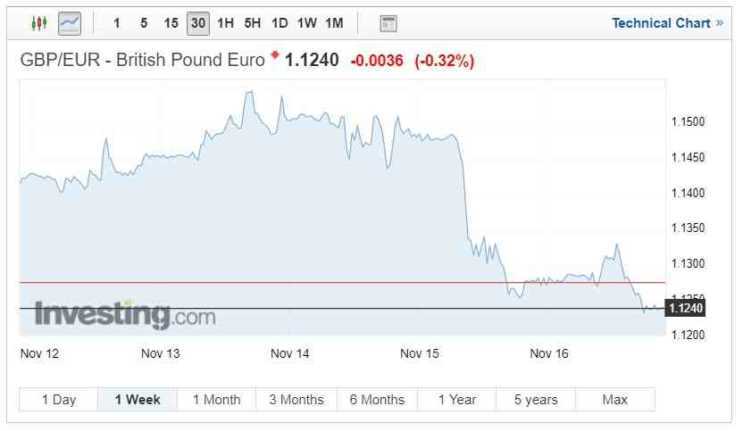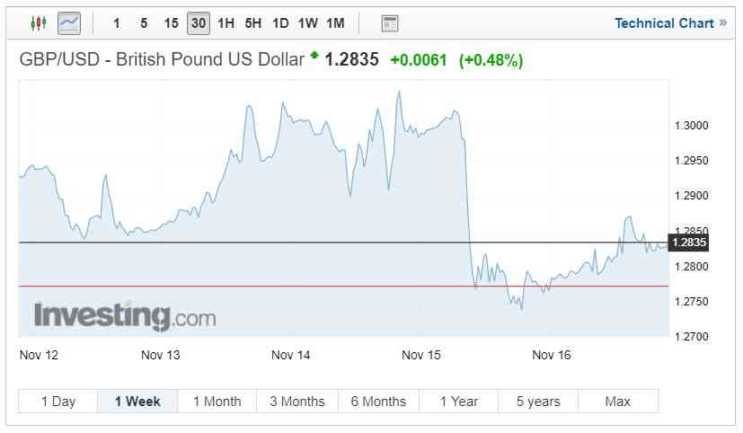The Pound jumped off a cliff this week as May’s Brexit draft agreement prompted a handful of cabinet members including the Brexit secretary Dominic Raab to resign. Slightly peculiar, bearing in mind Raab has resigned following the delivery of a Brexit deal he had negotiated with May and a few others.

The resignations prompted the Pound to spiral lower with the rout continuing for a good few days. Resignations have led to the very real possibility of May being ousted via letters of no confidence. The charge to oust the PM being led by the Rees Mogg and Johnson.
May promotes Brexit deal on radio waves
Before the dust had settled May went on the offensive, participating in a live radio interview on LBC. May answered a number of questions both surrounding Michael Gove’s apparent rejection of the Brexit secretary role and rumours that the DUP will not support her draft Brexit agreement.
Whilst some callers were more vocal accusing the PM of attempting to find middle ground rather than pursuing the electorate’s wishes May stood firm. One caller even requesting that May explain why she should stay on as Prime Minister has clearly failed to deliver the referendum result, to which May replied;
You’re absolutely right that for a lot of people who voted Leave, what they wanted to do was make sure that decisions on things like who can come into this country would be taken by us here in the UK, and not by Brussels, and that’s exactly what the deal I’ve negotiated delivers.
Following the Radio interview May then worked on an ambitious plan to shore up support for the draft and set about restructuring the fractured cabinet.
What does the EU UK deal look like?
May immediately faced an uphill challenge when she raised her hand and took over from David Cameron in 2016. The referendum vote was split down the middle with pro-Brexit voters being keen to take back control of immigration, wishing the UK to set its own laws and signed up for the belief that UK services could be overhauled by using cash that would have been destined for the EU.
May’s proposed settlement allows free movement of EU citizens until December 2020. Following this date, the UK concludes free movement and has the ability to set its own immigration policy. The agreement allows UK expats to remain in Europe providing they move before that date and EU citizen to remain in the UK before that date.
As regards law the European Court of Justice will have the final approval on the matter relating to EU law. This has been a huge negative for the pro-Brexit tory MP’s who wanted British courts to define UK law. Should the proposed legal backstop be executed, any differences of opinion are resolved by an arbitration panel which consists of representatives from the EU and the UK.
Whilst exactly how much will be saved and reinvested into services such as the NHS is yet to be seen the budget pledged investment regardless of the Brexit outcome. On the aforementioned LBC radio show May pledged that investment into the NHS would even surpass the figure quoted on Boris Johnson’s campaign buses.
Rees-Mogg calls no confidence
Another challenge that faces PM may is the mounting pressure and declarations of no confidence which will undoubtedly be piling up and approaching the 48 required to trigger a leadership contest. Jacob Rees-Mogg’s public declaration of no confidence as yet hasn’t initiated a challenge for May’s post. Rees-Mogg who chairs the European Research Group, an attachment of the Conservative party. The Group have made very clear their desire for a clean break from the EU, however, it is understood that if the 48 thresholds had have been passed an announcement would have followed from Sir Graham Brady chair of the 1922 committee, a leadership challenge would have then followed. As yet the threshold hasn’t been passed, this has allowed May valuable time to gain support for her draft with key cabinet members agreeing to stand by her and push the deal through.
The lack of further support has equated to nothing more than egg on Rees-Mogg’s face. Mounting challenge so late in the day can only be interpreted as self-indulgent publicity, especially given the fact that Mogg seems unsure to either endorse a successor or stand for the post.
Is May being now backed by the government or are more resignations expected?
May is clearly fighting hard to keep Brexit on schedule and gain support for her proposed deal. Once the dust had settled following the resignations and votes of no confidence PM May set about stabilising her cabinet and seeking their support.
It would appear at least during the meeting that May gained support from the cabinet despite some rumoured challenges.
In a poll of 505 Tory councillors, it has been found to no surprise that more voted against May’s draft Brexit agreement than for it. Nicola Sturgeon has confirmed her MP’s will vote down the draft Brexit deal, incredibly as has Dominic Raab one of the agreements key negotiators.
Whilst this saga is far from over for Theresa May at least she would appear to have the cabinets support currently. Mathematically it would appear getting the draft passed parliament will be difficult, especially if the DUP decide to vote against it and labour refuses to assist.
Pound exchange rates did recover from the week lows; therefore markets must be swaying towards May remaining rather than being ousted.
Will delaying Brexit cost the UK a further £10BN to leave the EU?
Whilst May is more than conscious that the upcoming week is critical the EU have seemingly been as keen as the MP to secure the draft agreement. Over the weekend the EU announced that any delay on Brexit could equate to £10 billion in supplementary payments.
Whilst May has secured backing from her cabinet some alterations have been proposed to draft, delays could therefore occur. Essentially the EU are proposing that the UK pay for a year-long extension on top of the pre-agreed £39 Billion divorce bill. This, if pursued by the EU would motivate the call for a hard Brexit and possibly bolster pro-Brexit Tory MP’s rationale for a clean break from the EU.
Pound plunges to 3 weeks low
The draft and political skull doggery and resignations have seen the pound collapse this week. On Tuesday evening rumours of the imminent draft agreement had propelled Sterling – Euro to a high of 1.1544, developments which followed the release of May’s draft agreement have seen the pair drop to lows of 1.1232 the lowest level since late October.
Whilst limited support has been reflected in this currency pair. Sterling-dollar did regain some composure in the final trading hour.
Pound Dollar gained just short of 0.5% on Friday, although the movement was exacerbated by comments reports that China and the US were still struggling to find common ground on a trade deal. The dollar’s slip was further compounded by comments from FOMC Member Neel Kashkari that the Fed should hold off on raising interest rates. The UK’s Brexit disarray has seen the GBP-US Dollar fall as low as 1.2739. The pair closed at 1.2835 on Friday as markets closed.

